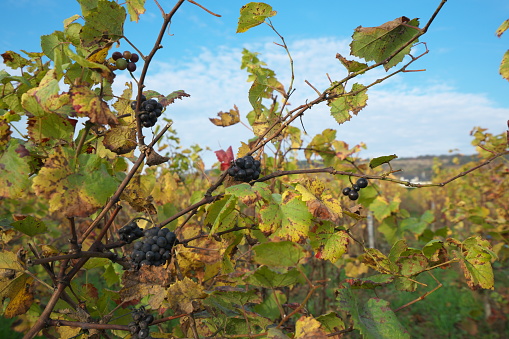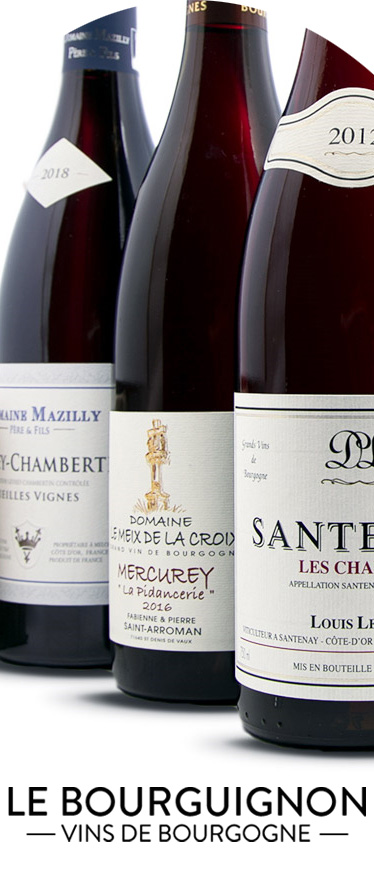The Côte de Nuits begins at the Marsannay appellation to the Clos des Langres (from Dijon in the north to Corgoloin in the south) in the Department of Côte d'Or (21).
Time stops in Côte de Nuits tonight, light wind, birdsong, clouds tinged with sun… She is beautiful our #Bourgogne 😍 pic.twitter.com/6O9fkGJpbb
— current PR (@actuellesRP) October 10, 2017
The vineyards extend over a narrow strip of hillsides of about twenty kilometers, this wine region offers about thirty appellations from the regional AOC to the grand cru including Romanée-Conti, the most expensive wine in the world.
The Côte de Nuits is renowned for its exceptional red wines (90% of the total production). The diversity of the terroirs allows each wine to be unique.
It is in this place of Burgundy that the most prestigious red grands crus are concentrated, hence the nickname "Champs Elysées de la Bourgogne". Indeed it is since the 1950s, that the winegrowers by their know-how and their knowledge of the grape variety (Pinot Noir) have made them the most sought after in the world!
The Côte de Nuits has six villages of great renown :
- Gevrey-Chambertin
- Morey
- Chambolle-Musigny
- Vougeot
- Flagey
- Vosne-Romanée
=> Particularity for the village of Gevrey-Chambertin, it alone has 9 Grands Crus, while the village of Vosne-Romanée has 6 Grands Crus.
In Burgundy, the different plots determine a regional, communal, premier cru and grand cru appellation according to their geographical location.
Hierarchy of appellations in Burgundy
In order to better navigate, its 83 appellations have been divided into 4 levels:
- Grands Cru appellations
- Premiers cru appellations
- Communal appellations (villages)
- Regional names (sometimes called "generic" or "sub-regional")
29 appellations, 24 Grands Crus for La Côte de Nuits
| The Grands Crus of Burgundy are at the top of the hierarchy since they have the best exposures and the most favorable microclimates . They are big names known internationally. |
The Grands Crus appellations of the Côte de Nuits (10% of the area of the Côte), classified by village:
- Gevrey-Chambertin
- Chambertin
- Chambertin-Clos de Bèze
- Chambertin Chapel
- Charms and Mazoyères-Chambertin
- Griotte-Chambertin
- Latricières-Chambertin
- Mazis-Chambertin
- Ruchottes-Chambertin
- Morey
- Clos Saint-Denis
- Clos de la Roche
- Clos des Lambrays
- Clos de Tart
- Bonnes-Mares
- Chambolle-Musigny
- Musigny (the only grand cru that produces white wine)
- Bonnes-Mares
- Vougeot
- Clos de Vougeot
- Flagey
- Scales
- Grands-Echezeaux
- Vosne-Romanée
- Romanée
- Romanée-Conti
- Romanée
- Richebourg
- The Task
- The Grande Rue
These Grands Crus of La Côte de Nuits produce only red wine except for one exception, the Musigny Grand Cru which offers white wine.
Why does the Côte de Nuits have so many great vintages ?
- a favorable climate, mainly oceanic with a semi-continental tendency (frequent rains all year round, cold winters and hot summers), the Côte de Nuits is colder than its neighboring wine regions
- a soil neither too thin nor too thick: the ideal is a soil between 30 and 50 cm as the Romanée-Conti appellation
- brown calcareous soils and rich in marl, the vines are composed of scree, red silt and pebbles. Each terroir is diverse which contributes to the typicity of each wine of the Côte de Nuits
- an exhibition due east
- a maximum altitude between 300 and 400 meters
- a gentle slope of 6% to 12%, perfect for water drainage
| The first growths of Burgundy are below the grands crus but they remain great wines as well. Each bottle is followed by the name of the plot and respects strict specifications (spacing between vines, pruning,…). |
Below is the list of villages of the Côte de Nuits offering premier cru appellations:
- Fixin (5 premier crus)
- Gevrey-Chambertin (25 premier crus)
- Morey-Saint-Denis (20 premier crus)
- Chambolle-Musigny (24 premiers crus)
- Vougeot (4 premier crus)
- Flagey-Echézeaux (2 premiers crus)
- Vosne-Romanée (13 premiers crus)
- Nuits Saint-Georges (41 premiers crus)
| The communal appellations of Burgundy correspond to the name of the village where the plot is located. |
The 10 communal appellations of the Côte de Nuits :
- Marsannay
- Marsannay Rosé
- Fixin
- Gevrey-Chambertin
- Morey
- Chambolle-Musigny
- Vougeot
- Vosne-Romanée
- Nuits-Saint-Georges
- Côte de Nuits Villages
=> The Côte-de-Nuits-Villages appellation comprises five communes, established in 1964 :
- Fixin
- Brochon
- Premeaux-Prissey
- Comblanchien
- Corgoloin
The Côte de Nuits-Villages appellation produces more tannic wines in the northern part and more flexible wines in the southern part. Most of the wines are very colorful, on the nose it is pleasant, aromas of red fruits (cherry, strawberry,…), black fruits (blackcurrant, blackberry,…), sweet spices (licorice,…) and animals (leather,…).
The regional appellations of the Côte de Nuits:
- Burgundy
- Burgundy Hautes-Côtes de Nuits
- Burgundy Hillsides
- Burgundy Aligoté
- Burgundy Passe-Tout-Grains
- Sparkling Burgundy
- Crémant de Bourgogne
In Côte de Nuits, it is the Pinot Noir grape variety that remains the majority, it is planted on 1,600 hectares and thirteen communes.
The Kingdom of Pinot Noir
The red wines of the Côte de Nuits are known to be the best in the world!
In general, the wine reveals a dark velvety red color, with a very expressive bouquet. We perceive aromas of red fruits (strawberry, raspberry,…), black fruits (blueberry, blackberry, cherry,…), flowers (peony, violet,…), plants (hay, mushroom,…). On the palate, firm wines, of a beautiful structure, tannic and structured with a remarkable aging capacity.
***
Some appellations of the Côte de Nuits produce dry white wines of great finesse and only the AOC communale marsannay produces dry and fruity rosé wine.
Rarer white wines
Unlike its neighboring region La Côte de Beaune which is known for its great white wines, La Côte de Nuits offers very few such as:
- Morey
- Musigny
- Vougeot
"Burgundy has done nothing better than this little corner where it has gathered its enchantments," writes Gaston Roupnel (1871-1946) about Vosnes-Romanée. This village on the Côte de Nuits is home to fabulous Grands Crus, which you surely know. Can you name them all? pic.twitter.com/WlSSYrPzSn
— Burgundy wines (@VinsdeBourgogne) July 2, 2020



